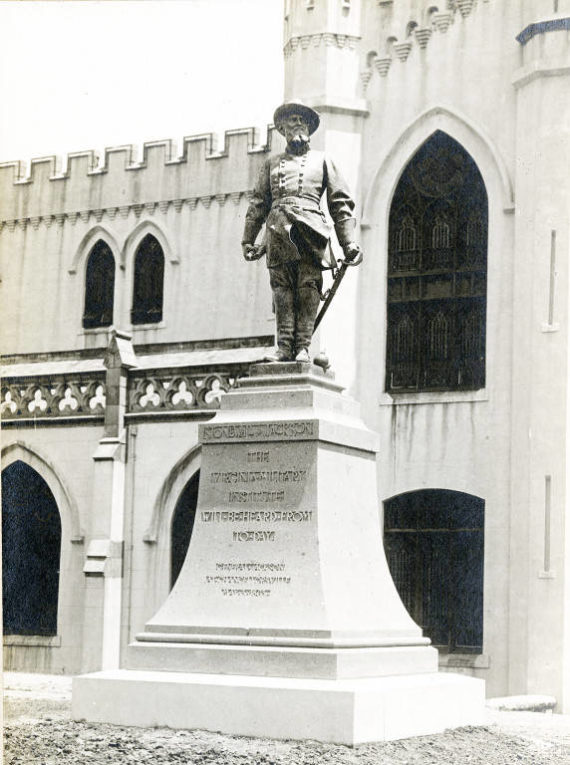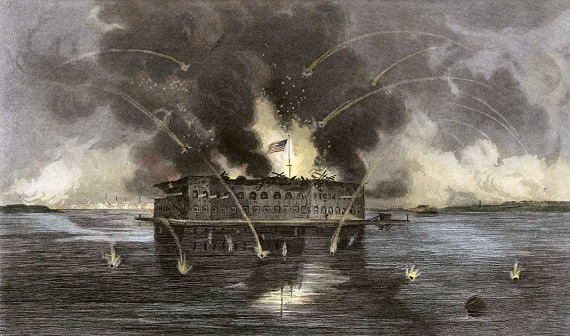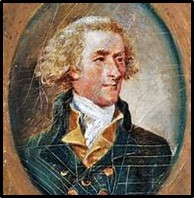In May of this year, George Floyd died; seven months later, the Virginia Military Institute (VMI) removed its statue of Thomas J. “Stonewall” Jackson from its prominent position at the nation’s oldest state-supported four-year military college. The two events – one in Minnesota’s largest city, the other in Virginia’s picturesque Shenandoah Valley – had nothing to do with one another. How did this happen; what are its implications?
In the wake of Floyd’s unfortunate death, a flurry not only of protests but also of writings on race ensued. In time, many of the latter took aim at VMI, a number of which asserted the school’s Confederate heritage had some connection with terms such as “structural” or “systemic” racism. Suddenly, the small but nationally-recognized military college, founded in 1839, was thrust into the limelight. One major problem with the charges – some of which have come from VMI graduates themselves – was that the published allegations fail to meet a traditional, objective definition of structural or systemic racism; in other words, racism that is part of the structure of the institution (school) itself. If such racism exists at VMI, it remains unsubstantiated as of this writing.
A survey of the articles on VMI and racism in the last six months suggests the allegations of racially-inspired acts – nearly uniformly attributed on the internet or in print to structural or systemic racism – were, in fact, acts of individual poor judgment or an individual’s racism: 1) a second-year cadet’s unserious but equally foolish threat to “lynch” a black cadet during a fevered workout for first-year “Rats” (for which the upperclassman was suspended, a significant discipline given the nature of the event in which the Rats were to undergo intense adversities to prove themselves, an integral part of VMI’s well-known adversarial, successful, model)[1]; 2) a professor’s thoughtless, “wistful” comments in class on the entertaining parties enjoyed years ago by her father, a KKK member; or, 3) some stupid or racially derogatory comments on social media. In fact, those are the three primary anecdotes that have been repeated over and over in news articles since June: none were structural (systemic, institutional) in nature; all took place in an individual or small-group/classroom context with a single protagonist or on social media (highly individualistic by its nature). It is altogether possible that the first two incidents were one-time events that have morphed into different versions in the reporting.
Certainly, individual acts of stupidity, poor judgment, or outright racism ought to be addressed (some, like the lynching threat, have been). Such incidents, however, are a much different thing than so-called structural (systemic, institutional) racism. Perhaps Virginia’s $1 million investigation of – in the governor’s words – a “clear and appalling culture of ongoing structural racism” [emphasis added] at VMI, will prove to be unfounded. Time will tell.
Before proceeding, a quick recap is in order. In July 2020, responding to allegations of racism at the school – including calls to remove the statue of Stonewall Jackson – VMI Superintendent J.H. Binford Peay III announced that the Institute was to shift focus from its first century’s record to its second century – in essence, devoting less attention to the school’s roots in the Confederacy but without disparaging those who served that government with honor and competence (for context, VMI men served the Confederacy for 4 years but the school has contributed military personnel to the U.S. armed forces for the vast majority of its 181 years). Retired U.S. Army General Peay directed a five-pillared approach, one of them “Education,” the core of which is a new American civics course, required for all second-year cadets. Further, VMI was to add course offerings in non-traditional, ethnic fields, including African history and the African-American experience – rational steps to increase inclusiveness.
Unfortunately, Governor Ralph Northam (VMI 1981) was unwilling to allow time for these measures to be implemented and to take effect. Instead, in October he wrote of his “deep concerns” about the “appalling culture of ongoing structural racism” at his alma mater and directed an investigation of the structural (systemic, institutional) assertions which – by brief analysis of the above-described incidents – were not structural but individual or small-group in nature.
A rational observer might question two things: 1) why the governor’s unwillingness to wait and observe the effects of General Peay’s measured reforms which already were underway; and, 2) why should the governor – in effect acting as both investigator-and-judge – charge VMI with an “appalling culture” concerning race – or anything else for that matter – prior to the discovery of the facts and context surrounding the allegations? Whatever the answer, it will not be to his credit. (Governor Northam may be grateful that he received far better treatment in 2019 when the news of his own youthful insensitivities regarding race came to light.)
Without doubt, the most serious charge is one directed at the VMI honor system – the heart and soul of the school, widely renowned and long respected. That charge has not been highlighted in most of the news articles. In a few pieces it seems almost to have been tossed in for good measure. At least one individual with some connection to VMI has charged that the honor system has been applied to black cadets with partiality. To anyone familiar with VMI, such a claim is difficult to believe. It is the one charge – reported without any specifics whatsoever – that, if substantiated, rips out the core of the Institute and requires rebuilding from ground zero. Based on two years as an honor court member in my own day, I do not believe the charge has merit. It certainly did not between 1978 and 1980. As readers may recall, all too often in 21st-century America the mainstream media jumps on the first thing they hear that fits The Narrative; only later, after reputations are called into question or ruined, are the facts sorted through. Associate Justice Brett Kavanaugh’s mistreatment was only one recent example. With VMI’s honor system, we shall see.
The real question concerns the legitimacy of terms like “structural racism” or “systemic racism” as they apply to VMI in 2020. The real answer: at VMI, they are not legitimate in 2020.
There was a time, however. An outstanding historical example of authentic structural racism in Virginia may be found in the Virginia Revised Code of 1819, which stated in part:
That all meetings or assemblages of slaves, or free negroes or mulattoes mixing and associating with such slaves at any meeting-house or houses, &c., in the night; or at any SCHOOL OR SCHOOLS for teaching them READING or WRITING, either in the day or night, under whatsoever pretext, shall be deemed and considered an UNLAWFUL ASSEMBLY. . . .[2]
(On a side note, it was this statute that Thomas J. Jackson knowingly violated because of his Christian commitment to teaching the slaves in his neighborhood to read the Bible.)
Sadly, a statewide code such as the above certainly fit the traditional definition of a structural, systemic, or institutional measure. Of course, it was only a half-century ago when other inequitable, structural measures regarding race were rectified in Virginia and throughout the nation, in connection with voting and other civil rights for all Americans.
Over the last half-century, VMI dealt one by one with structural (systemic, institutional) matters regarding race, although the term racism’s relevance was debatable. In the 1970s the band ceased playing Dixie (black cadets were admitted to VMI beginning in 1968). The President of VMI’s Class of 1979 was black. In 1982 the First Captain, the top position in the Corps of Cadets, was black – both men chosen not for the color of their skin but for their excellence and character as cadets. In the 1990s the Institute ceased using the Confederate flag. In 2015, the Rats stopped saluting Jackson’s statue for their saluting practice. Most likely, there is nothing that even approaches structural racism any longer at VMI, but that determination rests with Richmond.
Today, errors in thinking regarding what constitutes racism are all the more dangerous because the definitions of racism have changed. Basically, as some writers express, there was an “Old Racism” that existed in Virginia and elsewhere (not only in the South), and that may still be found, unfortunately, on a case-by-case basis. Today, however, there is also a “New Racism,” with its roots in neo-Marxist ideology modified from a focus on class to race by some who are committed to an anti-Western, lawless agenda. According to its poisonous tenets – in accordance with Critical Race Theory (CRT), with which the New (structural) Racism is part and parcel – all human relationships, laws, institutions, and societies are inherently racist and are to be defined by “oppressors” and the “oppressed.”[3] The oppressors are white; the oppressed are non-white. No neutrality is permitted under CRT, thus ensuring unrest, divisiveness, and agitation among any organization it touches. According to one CRT scholar, “Racism is no longer about individual discrimination. It is about systems that allow for disparate outcomes among racial groups.” King David of Israel put it this way: “What I did not steal, I then have to restore.”[4]
This New Racism, today most prominently espoused by Black Lives Matter (BLM), is the basis of the charges being leveled against VMI. Charges against VMI for its roots in the Confederacy, for example (including those made by one Virginia House delegate, VMI 2003) are code language for the New Racism – which itself, paradoxically, is highly racist.
One does not read very far on the official BLM website before encountering the term, “systemic racism.” BLM states, “The work is just beginning. We start by . . . holding the new president-elect . . . accountable to . . . campaign commitments of addressing systemic racism [emphasis added].” In another section of the website, BLM touts that “we disrupt the Western-prescribed nuclear family structure,” a traditional Marxist objective; thereby demonstrating BLM’s animus toward the West, including families, laws, and constitutions. So, when BLM or a BLM-informed entity speaks of systemic racism, one must conclude it refers to white-organized and -led institutions (the oppressors). Such institutions will always and forever be guilty of racism. It can be no accident that the terms systemic or structural racism used by BLM and other CRT/neo-Marxist based activists are the very ones that VMI’s antagonists are using.[5]
(If some readers view the terminology issue as no big deal, please be reminded that he who controls the language controls the culture; and that words mean things. In the history of U.S. military space, for example, the advance toward an independent space corps – now the U.S. Space Force – was hindered for years by the U.S. Air Force’s institutional use of the term and concept of “aerospace” as opposed to “air and space.”)
The VMI community, Virginians – indeed, Americans who care about the survival of their institutions – must reject completely the pernicious and poisonous concept of structural (systemic, institutional) racism under a neo-Marxist based definition. Otherwise, do not be surprised one day to find that not only has Stonewall’s statue been taken away; other institutions will necessarily follow, among them families, schools, businesses, and churches. If one of the most staunchly meritocratic, honor-bound, and – for decades – color-blind institutions in the country, the Virginia Military Institute, can be made to implement fundamental changes demanded by advocates of a neo-Marxist based ideology, all institutions are at risk.
[1] Ian Shapira, “Northam calls for VMI investigation after Black cadets describe relentless racism,” Washington Post, Oct. 19, 2020.
[2] “Slavery and the Making of America,” Original Documents, Excerpt from Virginia Revised Code of 1819.
[3] Tommy Curry, “Critical race theory,” Encyclopaedia Britannica, no date.
[4] Bari Weiss, “Stop Being Shocked,” Tablet Magazine, Oct. 14, 2020 [emphasis in original]; Quote from Psalm 69:4.
[5] “Join Black Lives Matter in Our Request for a Meeting with President-Elect Biden and Vice President-Elect Harris,” Black Lives Matter official website, Nov. 9, 2020.







